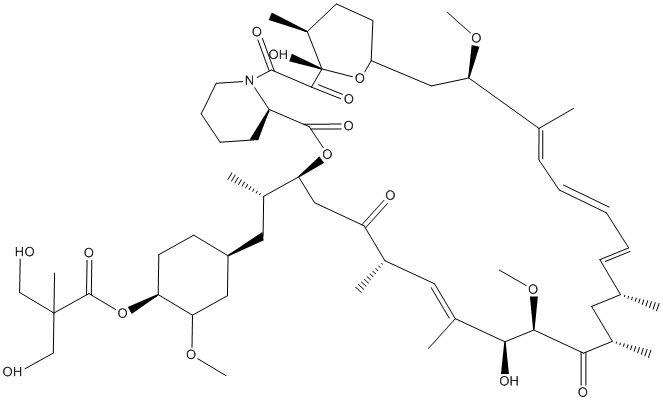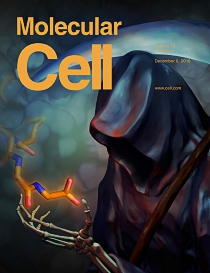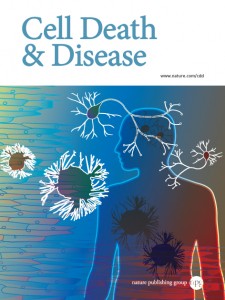All AbMole products are for research use only, cannot be used for human consumption.

Temsirolimus (CCI-779) inhibited the growth of xenografts derived from both cell lines with greater effects against PC-3 than DU145 tumors. Temsirolimus caused mild myelosuppression. The activity of mitoxantrone or docetaxel was limited, but CCI-779 given between courses of chemotherapy increased growth delay of PC-3 xenografts. High-dose temsirolimus inhibits mTOR signaling through an FKBP12-independent mechanism that leads to profound translational repression. This distinctive high-dose compound effect could be directly related to the antitumor activities of temsirolimus and other rapalogues in human cancer patients. The rapamycin analogue CCI-779 is an important new agent to investigate in the treatment of human brain tumors, particularly PNET/MB. The rapamycin analogue temsirolimus improved performance on four different behavioral tasks and decreased aggregate formation in a mouse model of Huntington disease.

Nat Commun. 2025 Mar 04;16(1):2191.
A metabolic synthetic lethality of phosphoinositide 3-kinase-driven cancer
Temsirolimus purchased from AbMole

Int J Nanomedicine. 2024 Sep 23;19:9821-9841.
pH-Responsive Block Copolymer Micelles of Temsirolimus: Preparation, Characterization and Antitumor Activity Evaluation
Temsirolimus purchased from AbMole

Journal of Pharmaceutical and Biomedical Analysis. 2023 Aug 14;115652.
Determination of five mTOR inhibitors in human plasma for hepatocellular carcinoma treatment using QuEChERS-UHPLC-MS/MS
Temsirolimus purchased from AbMole

Mol Cell. 2018 Dec 3.
Phosphorylated RB Promotes Cancer Immunity by Inhibiting NF-κB Activation and PD-L1 Expression.
Temsirolimus purchased from AbMole

Cell Death and Disease. 2018 Jan 26;9:137-52.
Downregulation of MCL-1 and upregulation of PUMA using mTOR inhibitors enhance antitumor efficacy of BH3 mimetics in triple-negative breast cancer
Temsirolimus purchased from AbMole

J Agric Food Chem. 2017 Mar 15;65(10):2089-2099.
10-Gingerol, a Phytochemical Derivative from “Tongling White Ginger”, Inhibits Cervical Cancer: Insights into the Molecular Mechanism and Inhibitory Targets
Temsirolimus purchased from AbMole
| Cell Experiment | |
|---|---|
| Cell lines | A549, H157, H460, H446, HCT116, HT29, SW480, DLD1, Caco2, LNCap, DU145, MDA468, MDA231, HEK293, and PC3-MM2 |
| Preparation method | Exposing cells to various concentrations of Temsirolimus for 72 hours. After treatment, using CellTiter AQ assay kit to determing viable cell densities by MTS dye conversion. |
| Concentrations | Dissolved in DMSO, final concentrations ~20 μM |
| Incubation time | 72 hours |
| Animal Experiment | |
|---|---|
| Animal models | Female athymic nude mice injected s.c. with DAOY, or U251 cells |
| Formulation | Prepared in 100% EtOH as a 50 mg/mL stock solution, and diluted in 5% Tween 80 and 5% polyethylene glycol 400 |
| Dosages | 20 mg/kg |
| Administration | Injection daily 5 times per week |
| Molecular Weight | 1030.29 |
| Formula | C56H87NO16 |
| CAS Number | 162635-04-3 |
| Solubility (25°C) | DMSO ≥40 mg/mL Ethanol ≥50 mg/mL |
| Storage | -20°C, protect from light, sealed |
| Related mTOR Products |
|---|
| RMC-4627
RMC-4627 is a selective mTORC1 inhibitor that activates 4EBP1 and inhibits tumor growth. |
| RMC-4529
RMC-4529 has an IC50 value of 1.0 nM against p-4E-BP1-(T37/46) in mTOR kinase cellular assay. |
| WYE-687 dihydrochloride
WYE-687 dihydrochloride is an ATP-competitive mTOR inhibitor with an IC50 of 7 nM. |
| Rapamycin-d3
Rapamycin-d3 |
| L-Leucine-d10
L-Leucine-d10 |
All AbMole products are for research use only, cannot be used for human consumption or veterinary use. We do not provide products or services to individuals. Please comply with the intended use and do not use AbMole products for any other purpose.


Products are for research use only. Not for human use. We do not sell to patients.
© Copyright 2010-2024 AbMole BioScience. All Rights Reserved.
